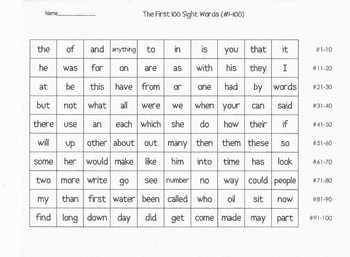

There is nothing wrong with having lists of high frequency words that students should learn. Is there anything wrong with using the Dolch and Fry lists?
List of 100 sight words how to#
Instead, he focused on teaching students to memorize the most common high frequency word from his Fry Lists, which contain all parts of speech.Īccording to Fry, in his book, How to Teach Reading, students should learn the first 100 words in their first year of school, the second hundred in the second year, and the third hundred in the third year. He did acknowledge that teachers should teach phonics, but he didn’t have much to say about it. For example, “yellow” is on the pre-primer list, but “if” is on the third grade list.Įdward Fry, like Edward Dolch, believed in the look-say method of teaching reading. However, these groupings really don’t make sense. You’ve likely found lists of Dolch words organized by grade level. This list of 220 words contains no nouns Dolch later created a set of 95 nouns, but his original list consists of “service words” because these words appear in any type of text, no matter the content. However, his original list of 220 high frequency words remains popular today. Therefore, we need to seriously question completely abandon Dolch’s approach. In his book, Teaching Primary Reading, Dolch even stated that first graders should learn only sight words, and teachers should wait until second grade to introduce phonics (!!).įor decades, the science of reading has shown the importance of beginning phonics instruction.

(Now that we understand how the brain learns to read, we understand that this is a faulty method of teaching reading). He believed that reading instruction should begin by teaching children to memorize words based on their shape. Edward Dolch in 1936.ĭolch was a proponent of the “look-say” method of teaching reading. Once children begin reading books, they open the doorway to learning even more words.

If a child can read these 100 words, there are many easy reader books that a child can read. So the list in the article can be helpful as it aligns with these already accepted lists. For example, the sight words that have the letter ‘H’ as their first letter are his, her, had, he, etc., and the sight words that start with the letter ‘T’ are this, that, them, etc. Common lists used in classrooms include the Fry’s list or Dolch list. Our goal for our students is that they turn high frequency words INTO sight words.īut where do we get these high frequency words FROM?Įnter Dolch and Fry. For this fun game, you can ask your child to say one sight word that starts with each letter of the alphabet.


 0 kommentar(er)
0 kommentar(er)
